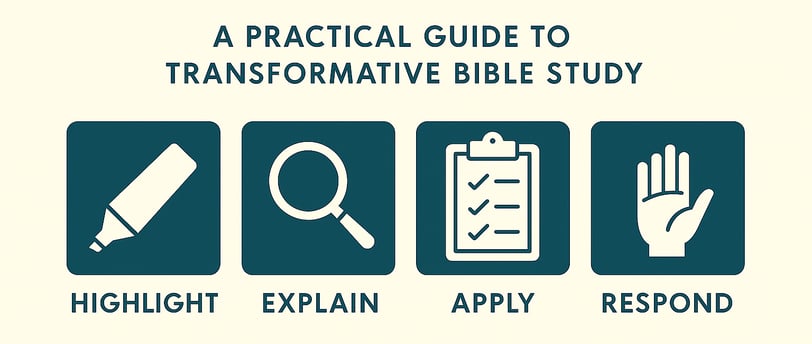The HEAR Method: A Practical Guide to Transformative Bible Study
Many Christians seeking spiritual growth long for a Bible study method that is both accessible and transformative. The HEAR Method—Highlight, Explain, Apply, Respond—provides a simple yet powerful framework for engaging with Scripture in a way that leads to genuine life change.
Dan Burnfield
6/22/20255 min read


Introduction
In the pursuit of spiritual growth, many Christians find themselves searching for a Bible study method that is both accessible and transformative. The HEAR Method—an acronym for Highlight, Explain, Apply, Respond—offers a simple yet deeply effective framework for engaging with Scripture. Whether you are new to Bible study or seeking to revitalize your devotional practice, the HEAR Method can help you move from passive reading to active, life-changing encounter with God’s Word.
What Is the HEAR Method?
The HEAR Method is designed to guide you through four intentional steps as you read the Bible:
Highlight: Mark key words or phrases.
Explain: Summarize the meaning in your own words.
Apply: Identify how it applies to your life.
Respond: Pray or act on what you’ve learned.
This approach is built on the conviction that the Bible is not just to be studied for information, but to be lived for transformation.
Why Use the HEAR Method?
The effectiveness of any Bible study method lies in its ability to engage both the mind and the heart. The HEAR Method is particularly powerful because it:
Encourages careful observation and reflection.
Bridges the gap between understanding and application.
Fosters a habit of prayerful, obedient response to God’s Word.
Is simple enough for daily use, but deep enough to yield lasting change.
Step 1: Highlight – Mark What Stands Out
The first step in the HEAR Method is to Highlight key words, phrases, or verses as you read a passage of Scripture. This is more than just underlining your favorite verse; it is about training your eyes to notice what is significant, repeated, or surprising.
How to Highlight Effectively:
Use a pen, pencil, or digital highlighter to mark words and phrases that catch your attention.
Look for repeated terms, commands, promises, or contrasts.
Pay attention to connecting words (“therefore,” “but,” “so that”) that reveal the flow of thought.
Mark anything that raises a question or stirs your heart.
Example:
Reading Psalm 23, you might highlight “The Lord is my shepherd,” “I shall not want,” “He restores my soul,” and “I will dwell in the house of the Lord forever.”
Why Highlight?
Highlighting slows you down and helps you focus. It trains you to see the details that make a difference in understanding and applying God’s Word.
Step 2: Explain – Summarize the Meaning
After highlighting, the next step is to Explain what the passage means. This involves putting the text into your own words, clarifying its meaning, and ensuring you have grasped the author’s intent.
How to Explain:
Paraphrase the highlighted verse or passage in your own words.
Consider the context—what comes before and after? Who is speaking, and to whom?
Ask, “What is the main point? What is the author trying to communicate?”
Use study tools if needed, but aim to express the meaning simply and clearly.
Example:
If you highlighted “The Lord is my shepherd,” you might explain: “God cares for me and provides for all my needs, just as a shepherd cares for his sheep.”
Why Explain?
Explaining helps ensure you understand the passage. It moves you from surface reading to real comprehension and guards against misinterpretation.
Step 3: Apply – Bring It Into Your Life
The third step is to Apply the passage to your own life. This is where the Bible moves from ancient words to present reality. Application asks, “How should this truth change me?”
How to Apply:
Ask, “Is there a command to obey, a promise to claim, a sin to confess, or an example to follow?”
Consider how the passage speaks to your current circumstances, relationships, or struggles.
Be specific—think about attitudes, actions, and decisions that need to change.
Write down one concrete way you will live out the truth today.
Example:
From Psalm 23, you might apply: “When I feel anxious about the future, I will remember that God is my shepherd and trust Him to provide.”
Why Apply?
Application is the bridge between knowledge and transformation. Without it, Bible study remains theoretical; with it, God’s Word becomes personal and powerful.
Step 4: Respond – Pray or Act
The final step is to Respond. This is your opportunity to turn what you’ve learned into prayer, worship, or action.
How to Respond:
Pray through the passage, thanking God for what He has shown you.
Confess any sin or weakness the passage has revealed.
Commit to a specific action or attitude change.
Share your insight or application with someone else for encouragement or accountability.
Example:
After studying Psalm 23, you might pray: “Lord, thank You for being my shepherd. Help me to trust You today and rest in Your care.”
Why Respond?
Response is where transformation takes root. It is the step that moves you from being a hearer of the Word to a doer (James 1:22).
The HEAR Method in Practice: A Walkthrough
Let’s see how the HEAR Method works with a familiar passage—Philippians 4:6–7:
“Do not be anxious about anything, but in everything by prayer and supplication with thanksgiving let your requests be made known to God. And the peace of God, which surpasses all understanding, will guard your hearts and your minds in Christ Jesus.”
Highlight:
“Do not be anxious about anything”
“by prayer and supplication with thanksgiving”
“the peace of God… will guard your hearts and your minds”
Explain:
Paul is telling believers not to worry, but to bring every concern to God in prayer, with a thankful heart. When we do this, God promises to give us a peace that protects our hearts and minds.
Apply:
When I start to worry about work or family, I will stop and pray, thanking God for His faithfulness and asking for His help.
Respond:
“Lord, I give You my worries today. Thank You for Your promise of peace. Help me to trust You and rest in Your care.”
Tips for Using the HEAR Method
Be Consistent: Set aside regular time each day for Bible study.
Be Honest: Write down your real thoughts, questions, and struggles.
Be Prayerful: Ask the Holy Spirit to guide you at every step.
Be Accountable: Share your insights and applications with a friend or group.
Be Patient: Growth takes time. Celebrate small steps of obedience.
Common Questions About the HEAR Method
Q: Can I use the HEAR Method with any passage?
A: Yes! It works with short verses, chapters, or even whole books. Start small and expand as you gain confidence.
Q: What if I don’t understand a passage?
A: Use the Explain step to write down your questions. Consult a study Bible, commentary, or ask a mature Christian for help.
Q: Do I have to write everything down?
A: Writing helps, but you can also use the method mentally or discuss it aloud. The key is to engage actively.
Q: How long does it take?
A: The HEAR Method can be done in as little as 10–15 minutes, but take more time if you can. Depth comes with reflection.
The HEAR Method and Spiritual Growth
The HEAR Method is not just about mastering a technique—it’s about meeting God in His Word. As you highlight, explain, apply, and respond, you will:
Grow in biblical understanding.
Develop habits of prayer and obedience.
Experience God’s guidance and comfort in daily life.
See real change in your attitudes, relationships, and priorities.
The Bible promises that God’s Word is “living and active” (Hebrews 4:12). The HEAR Method is a way to experience that living power for yourself.
Conclusion: Start Today
If you’re looking for a Bible study method that is simple, practical, and transformative, try the HEAR Method. Open your Bible, open your heart, and let God speak. As you highlight, explain, apply, and respond, you’ll discover that God’s Word is not just something to be studied—it’s a living voice that calls you to know, trust, and follow Him.
Try it now:
Choose a passage—perhaps Psalm 1, John 15, or Romans 8. Walk through the HEAR steps. See what God will do as you listen and respond to His Word.
Let the journey begin!
